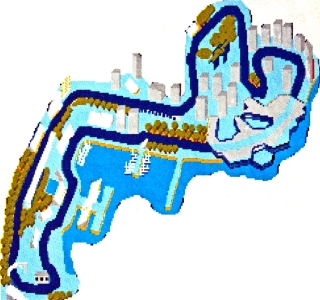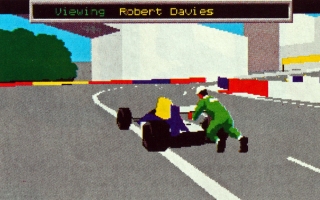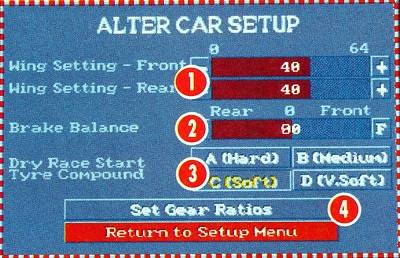
Fast cars and loose women. Fast women and loose cars. It's all the same in the heady world of Formula One Grand Prix racing. The thrill of 'accidentally'' running over an engineer! The fear as you round a corner and find you're going the wrong way round the track! The pause button as you flick through the manual to find what that flag means!
All right, so there not very likely in real F1, but your first few games of F1 Grand Prix is full of stuff like this. This is a simulation, not a race game like 0utrun or Worm, so you can't just hop into the cockpit and lap Ayrton Senna.

The white line running down the middle of the track is, of course, a lane guide. Cars going this way drive on the left, whereas cars coming the other way are supposed to drive on the right. Or is it the ideal driving line? Something like that.

Pit stops are easy. Scream in at 175 mph, blast past the other boys, then your guided in. You just have to stop before you run over the mechanic. Then it’s a quick wipe, a tyre change, some encouraging words from the crew like "you’re last” and you’re off again.
In essence, FIGP is a complete simulation of the 1991 season, with all its drivers, teams, tracks and cars. If you were foolhardy, you could jump right in ant attempt an entire season, starting in Phoenix and ending in Adelaide. This would probably result in your car being smashed up sometime in the first 20 seconds of the Phoenix race. The best idea, of course, is to get in some practice on each track first. There are several ''levels'' of practice. The first is a simple whizz-round the chosen track without any other cars present. Next comes the non-championship race in two flavours: free practice - a race up to two hours with all 26 cars - and a qualifying race. Here you can enter the pits at any point you feel you've achieved a good time.

Monaco in all its glory. For a real laugh, zoom off at
loews (the hair-pin bend that doubles back on itself)
and sit in the middle of the track. Then watch the
other cars desperately trying to squeeze through.
Chuckle chuckle.
When you've earned a good grid position - and had one last pre-race practice - you can do the actual race itself. The same applies to a Grand Prix race. So, there are plenty of chances to learn each circuit better than the inside of your mouth and no excuses for crashing. Even fewer when you consider there are six ''cheat'' modes available. For instance, let' s assume you're crap at changing gear: switch on the auto gear changer and you don't have to worry about it. The ST even controls the braking and makes you indestructible if you like. (of course you can't use these cheats in the Grand Prix mode. After all, you're not French.)
Control is entirely by joystick, except for a few keys that toggle the driving aids. All these aids are useful when you're learning to drive at 175 mph, but once you've got the hang of it (after, say, five years practice) you find the most useful is the ideal driving line.
This aid lays a dashed line on the track. Theoretically, following this line results in the fastest time possible on that track, because it's set up to take you around corners in the most efficient way. Not that following the line is easy - usually you spend so much time staring at the track you sort of forget the other cars. Then, to make things even more complicated, there's the matter of your car's setup. It's not enough to change the tyres and the oil every now and again in F1. You need to and every circuit. In practice, this means adjusting the front/rear wing down force, the front/rear brake balance, the gear ratios and the tyres. These techie bits have an Optimum setting for each track and it's up to you to find it. This means plenty of practice laps and much fiddling with the controls.

“Get off! Look, I could’ve got back into the race easy! Right, that’s it. Give me your name. I’ll have you struck off the – the – Marshal’s list. You’re never going to work again chummy.”

Now, you didn’t want to do that. You can take three major knocks before you’re winched off. The front of your car goes wonky and becomes almost impossible to control.
FIGP is a simulation that takes its graphics seriously as well as its subject. Each car is displayed in true 3D, not just from an anterior viewpoint, so when they spin, you see them spin. In addition, they're all marked up with the correct team colours and even the drivers helmets are marked correctly. (No advertising, though.) There are marshals to the side of the track waving flags, marshals pushing off cars that have given up, a pit crew that wipes your windscreen for you, and even spurious details like the boat in the harbour at Monaco. This sort of detail tends to make the game's response a little sluggish and the frame update is nowhere near that of vroom. Turning off some detail does speed things up, however.

Wow! Just look at that car scream round that corner
and… reverse into the pits? Yes, Indeed, Formula One
Grand Prix is better than the real thing. Any game that
means you can do things like that can’t be bad.
Out-of-cockpit viewpoints can give you a whole different look at things, but they're not recommended for use when you're actually driving. They are good, though, for watching spectacular pileups around a 180 degree bend. It can also be used as a teaching aid: watching a hot-shot driver as he slipstreams past an opponent can give you valuable lessons in how to get it right.
Apart from the frame update, the only disappointing effects are the audio ones, In Vroom, they were perfect: huge, noisy engine rev samples, which pumped up the adrenaline brilliantly. Unfortunately here you get the standard weedy sewing-machine-about-to explode chip noise. First it annoys, then irritates, and finally it's turned down.
VERDICT
Great. Well, fairly great. Because it's such a good simulation it's not such a good game; you need to put in slightly less effort than a real driver to even think about winning your first race, but only slightly less. We are talking serious late-night gameplay here.
Simulatory-wise you can't do better: everything's here save the Fleetwood Mac music. But don't expect to be gripped the moment you set hands on the wheel. You can yawp at the graphics flick through the views and marvel at the detail, but when it comes to driving… 15 races after you first load it up you begin to realise why the real life drivers earn so much money. It's hard.
But, like most hard things, it's worth practising, Eventually you get to a point where you can just about begin to challenge the weaker drivers on the grid, and, from then on in, there's no stopping you. Weeks zoom by as you ceaselessly try to better your race time. You start telling people fascinating facts about the Grand Prix circuits. There's a feverish gleam in your eye: victory lust, pure and simple. So it's quite good really. For this price, though, you need to be sure it's the sort of game you want. For an exhilarating scream around some easy circuits, go for Vroom. For an in-depth, difficult and ultimately very rewarding simulation (let's face it, it's the nearest you're ever going to get to being in the cockpit) F1GP delivers, but slowly.
Ed Ricketts

(2) Distribution of performance - the other cars can drive at their 1991 performance, at a random levels or with the same potential performance. Which is harder and which easier is up to you
(3) Rev counter - counts revs. And does it rather well
(4) Driving aids - auto brakes, auto gears, self-correcting spin, indestructible mode, ideal racing line and suggested gear
(5) Driving status indicator - lights up when you re viewing your own cockpit. Useful for when you're flicking between various views (which isn't really advisable when you're driving anyway)
(6) Gear indicator - as well as the normal first to sixth gears, there' s neutral, reverse (reverse? In a F1 car? Nasty) and a "power turn" gear so you can face the right way round after a spin-off
(7) Detail on/off - as usual, more detail means a slower display but prettier pics. And vice versa.
(8) Damage indicator - don't get this completely lit up; you'll live (or not) to regret it
(9) Pits indicator - lights if you want to make a pit stop, and automatically if the crew think you should stop

(2) Front/rear brake balance - alters the way in which the brakes are applied. It's best to have the bias towards the front brakes so the front wheels begin to stop before the rear ones
(3) Tyres - range from "A" (hard) to "D" (very soft). Softer tyres grip the track well and give excellent control in corners, but wear out ridiculously quickly. And, of course, the harder tyres last for ages but don't grip much. Qualifiers are ultra ultra sticky, but wear out almost before you put them on
(4) Gear ratios - these relate to the way the gears are set up which affects the speed you can move up through them. "Short" gearing, where the cogs are close to each other, is great for tortuous tracks where quick acceleration is needed. "Long" gearing, the opposite, is best for straighter tracks where constant speed is desirable. "Silly" gearing is when you wear baggy trousers and put your baseball cap on backwards
GRAND PRIX
- Disappointing sound effects shave a few points off its score.
- Unlike Vroom, Formula One Grand Prix is not the sort of thing you would load up just for a quick drive.
- Incredibly detailed, but also extremely difficult to get absorbed into. Patience is rewarded however.
- Better and more realistic graphics in this game than you’re likely to find anywhere else, but they tend to slow the display down perhaps a little too much.





